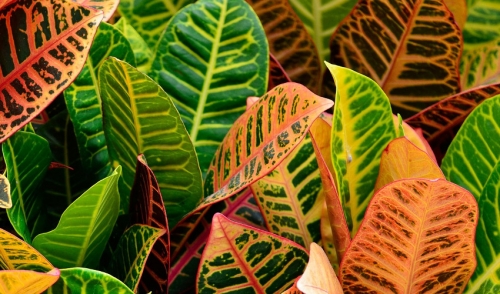
Landscaping With Crotons
Crotons are popular in all types of tropical landscaping, but are they right for your garden, flowerbeds or containers? Understanding more about these plants can help you use them in the very best way to ensure they not only thrive in your landscape, but that they become a beautiful focal point for you to enjoy.
About Crotons
Crotons (Codaeum variegatum), also called garden crotons or variegated crotons, are perennial evergreen shrubs that do best outdoors in planting zones 9-11, but are also popular additions to indoor landscaping in greenhouses or as house plants. There are many different croton cultivars to choose from, including dwarf varieties, but all have broad, leathery leaves with bold, colorful patterns that may be red, pink, orange, yellow, black or white, contrasting with the otherwise green foliage.
Depending on the type of croton, these slow-growing shrubs can eventually reach 6-8 feet in height and may spread 3-6 feet wide. Once established, they are relatively low maintenance, making them a favorite for low key landscaping design.
Crotons originated in Indonesia, but because of their landscaping popularity, they are readily found in any tropical or semi-tropical zone, ready for planting and enjoyment.
Planting Crotons
Crotons are relatively easy-going plants in the landscape, but they don't tolerate wet feet well and should be planted in well-drained soil. They will thrive in either full sun or part-shade locations, though in shadier spots their colors may be more muted. In the hottest regions, however, shadier planting locations are ideal to ensure they aren't burned or dehydrated too quickly, particularly when they are planted for afternoon shade to cut the hottest of the sun's rays. In cooler climates, these plants should be protected from harsh winds that can quickly dry out their broad leaves and cause leaves to fall.
Ideally, crotons should be planted 2-3 feet apart to allow for adequate growth without looking too far apart while waiting for the plants to fill in. The plants should be watered regularly but allowed to dry out slightly between waterings, though they do become drought-tolerant once established. A gentle application of a slow-release fertilizer can be helpful to nourish young crotons.
Landscaping Ideas for Crotons
These shrubs have many beautiful uses in the landscape and can look stunning when planted in groups or used as specimen plants for containers. Popular options for showing off crotons include…
- Planting lines of crotons to create colorful hedges or barriers
- Arranging these shrubs alongside a pool, whirlpool or fountain
- Lining a driveway, sidewalk, garden path or similar walkway
- Planting groups beneath palms or other tropical trees
- Adding a pop of croton color to a perennial flowerbed
- Surrounding a mailbox post, flag pole or lamppost
- Disguising a building's foundation or providing color at the base of a structure
With so many attractive ways to use crotons, and so many varieties of these colorful plants to choose from, there's room in your landscape for plenty of these amazing shrubs.

